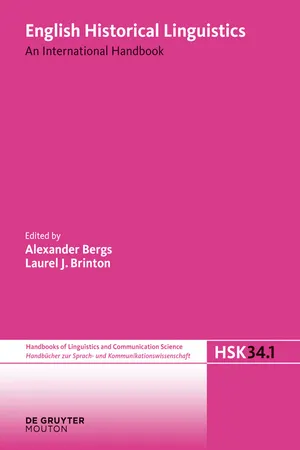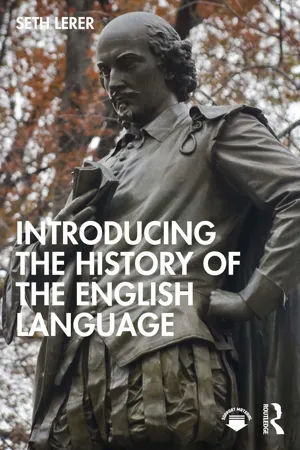Languages & Linguistics
Old English Translation
Old English translation refers to the process of rendering texts from Old English, the language spoken in England from the 5th to the 11th century, into modern languages. This involves understanding the nuances of Old English grammar, vocabulary, and syntax, and accurately conveying the meaning and style of the original text in the target language.
Written by Perlego with AI-assistance
Related key terms
1 of 5
5 Key excerpts on "Old English Translation"
- (Author)
- 2010(Publication Date)
- Elsevier Science(Publisher)
London: Oxford University Press. English, Old English C L Allen , Australian National University, Canberra, Australia ß 2006 Elsevier Ltd. All rights reserved. Old English is the development of the language which was introduced into Britain by Germanic invaders in the 5th century A . D . and became the dominant lan-guage of what is now England excluding Cornwall, and also southern Scotland. Old English evolved gradually into Modern English, and any date given to delineate the different stages of the language must be somewhat arbitrary. The period covered by Old English spans c. 425 to c. 1100, and the language underwent extensive changes in this period. The com-ments made below about the phonology and gram-mar of Old English must be understood to apply to some of this period, but not necessarily all. By 1100, the accumulation of changes had become so great that it is appropriate to speak of Middle English. While we do not know what the earliest Germanic people coming to Britain called their language, we find it referred to as englisc c. 1000, and Engla land (land of the Angles) used for the area where it was spoken. It is impossible to estimate the number of speakers throughout the Old English period, but William the Conqueror’s Domesday Survey (1086) sug-gests an Anglo-Saxon population of between one and two million. It is customary to recognize four basic dialects of Old English, distinguished from each other most prominently by phonological features but also by mor-phological and lexical peculiarities: Northumbrian (northern), Mercian (midlands), Kentish, and West Saxon (southwestern). It is tempting to attribute the main dialect differences to the premigration period on the continent, following the tradition beginn-ing with the famous description of the Germanic inva-ders in Bede’s Ecclesiastical history of the English people .- eBook - PDF
- Alexander Bergs, Laurel J. Brinton, Alexander Bergs, Laurel J. Brinton(Authors)
- 2012(Publication Date)
- De Gruyter Mouton(Publisher)
With an English translation, the Latin text, notes, and an introduction. (Early English Text Society 45.) London: N. Tru ¨ bner & Co. Wollmann, Alfred. 1993. Early Latin loan-words in Old English. Anglo-Saxon England 22: 1–26. Zupitza, Julius (ed.). 2000 [1880]. Aelfrics Grammatik und Glossar . 3rd edn, with a new introduc-tion by Helmut Gneuss. Berlin: Weidmann. Gernot R. Wieland, Vancouver (Canada) 24 Old English: Standardization 1 Introduction 2 Establishing a norm: earlier scholarly approaches to standardization in Old English 3 Theoretical and descriptive frameworks in current research 4 Major forms of standardization in Old English 5 Further instances of standardization 6 Summary 7 References Abstract Despite the ongoing debate about the appropriateness of the concept of standardization in an Old English context, scholars concur that the earliest stage of the English language exhibits clear traces of language regulation. Two major processes that differ in their lin-guistic character and geographical extension have been identified: (1) the so-called “ Winchester vocabulary ” , a lexical norm taught and practiced at Winchester cathedral school in the late 10th and in the 11th century, and (2) “ Standard Old English ” , an ortho-graphic norm based on the West-Saxon dialect, whose regulating effect on spelling and inflexional morphology manifests itself in late Old English manuscripts originating in all parts of England from the late 10th to the early 12th century. The sociolinguistic turn brought about by the Norman Conquest deprived the normative tendencies manifest in Old English of their linguistic foundation and their institutional support. - No longer available |Learn more
- (Author)
- 2014(Publication Date)
- University Publications(Publisher)
Comparison with other historical forms of English Old English is often erroneously used to refer to any form of English other than Modern English. The term Old English does not refer to varieties of Early Modern English such as are found in Shakespeare or the King James Bible, nor does it refer to Middle English, the language of Chaucer and his contemporaries. The following timeline helps place the history of the English language in context. The dates used are approximate dates. Language change is gradual, and cannot be as easily demarcated as are historical or political events. • 450–1100: Old English (Anglo-Saxon) – The language of Beowulf and Alfred the Great. • 1100–1500: Middle English – The language of Chaucer. • 1500–1650: Early Modern English (or Renaissance English) – The language of Shakespeare and the King James Bible. • 1650–present: Modern English (or Present-Day English) – The language as spoken today. Examples Beowulf The first example is taken from the opening lines of the epic poem Beowulf . This passage describes how Hrothgar's legendary ancestor Scyld was found as a baby, washed up on the shore, and adopted by a noble family. The translation is quite literal and represents the original poetic word order. As such, it is not typical of Old English prose. The modern cognates of original words have been used whenever practical to give a close approximation of the feel of the original poem. The words in brackets are implied in the Old English by noun case and the bold words in parentheses are explanations of words that have slightly different meanings in a modern context. Notice how what is used by the poet where a word like lo or behold would be expected. This usage is similar to what-ho! , both an expression of surprise and a call to attention. Line Original Translation Hwæt! wē Gār -Dena in ġeār -dagum, What! We of Gare-Danes (lit. Spear-Danes) in yore-days, - eBook - ePub
Beowulf and Other Stories
A New Introduction to Old English, Old Icelandic and Anglo-Norman Literatures
- Joe Allard, Richard North(Authors)
- 2014(Publication Date)
- Routledge(Publisher)
Naturally, I am going to take the position that Old English is not only easy but also worth learning. But along the way I shall try to give you enough information about the language to allow you to come to your own conclusion. Old English is a language like other languages OK, so Old English is a language. Why am I pointing out something as obvious as that? Old English used to be universally taught as a linguistics course, in which students learned not only the language, but also learned in great detail how each of its features had descended from Germanic and Indo-European originals. People who were forced to take such courses often moan (sometimes in the Guardian or Times Literary Supplement) about the pain and boredom of the experience. Historical linguistics – the study of how languages change over time – is a lively field that a great many students find fascinating. Many find it worthwhile to know the place of English in the Germanic sub-family of languages and the place of Germanic in the enormous and ancient Indo-European language family (see Chapter 1, p. 8). Many also find it edifying to learn how and why English has changed over the centuries, if only because the language is still changing, more or less rapidly, everywhere it is spoken. But you don’t need to become a historical linguist if your purpose is to read Beowulf or The Anglo-Saxon Chronicle, any more than you need to learn the history of French to read Flaubert or navigate the Champs Elysées. One would have thought it obvious to everyone that any language can be learned without resort to historical linguistics. But no, even today there are textbooks that insist, either explicitly or implicitly, that one must study certain ‘sound changes’ in order to learn Old English - eBook - ePub
- Seth Lerer(Author)
- 2024(Publication Date)
- Routledge(Publisher)
3 The Old English PeriodDOI: 10.4324/9781003227083-4Old English (OE) describes the Germanic vernacular spoken and written in the British Isles from roughly the middle of the fifth century until the early twelfth century. OE shared features of grammar, sounds, and vocabulary with other early Germanic languages and many modern ones. It was highly inflected, using word endings to determine the relationships among words in a sentence. Nouns had grammatical gender (masculine, feminine, and neuter); they belonged to certain groups or classes (depending on their sound histories of their roots); they were declined in a variety of cases, depending on their grammatical function; and there had to be agreement with adjectives that modified them (that is, similar endings depending on the number, case, and gender of the noun). Verbs were conjugated according to tense and number; verbs were also grouped into classes depending on their sounds and sound histories; and certain verbs formed their tenses by changing the root vowel (strong verbs, such as drink, drank, drunk) and others formed their tenses by adding a suffix (weak verbs, such as live, lived). OE had a distinctive sound (one that has been reconstructed, with reasonable accuracy, by scholars over the past three hundred years) and a distinctive way of forming letters in writing (adapting old runic letters for sounds not found in the Latin alphabet). It was the medium of prayer, scholarship, history, poetry, and philosophy for more than four hundred years.This chapter illustrates the distinctive features of OE and gives students basic reading knowledge of the language so that they may understand its place in English linguistic history and the literary imagination. We will also see how studying OE gives us access to a political and social world, to myth and religion, and to creativity and culture. OE was not a single, static language, however. Over the seven centuries of its use, it changed: new words came in from Latin and Scandinavian languages; word endings appear to have been leveled out or even lost; patterns of word order and particulars of literary style evolved. In addition, OE varied in sound and sense across the British Isles. Scholars have identified four major regional dialects by examining the spelling of words in surviving manuscripts. Old English was the language of kings and agricultural workers, poets and monks. It was a vernacular marked by nuance and variety, depending on the who, when, and where of its use.
Index pages curate the most relevant extracts from our library of academic textbooks. They’ve been created using an in-house natural language model (NLM), each adding context and meaning to key research topics.




